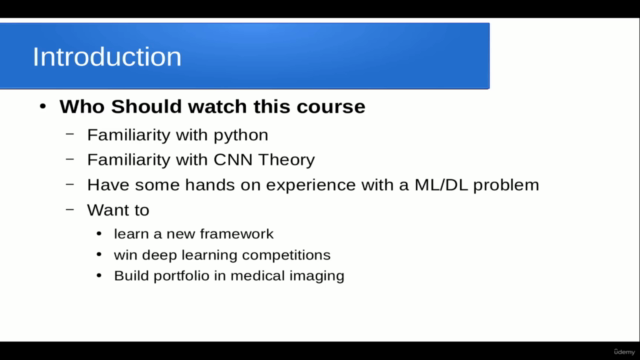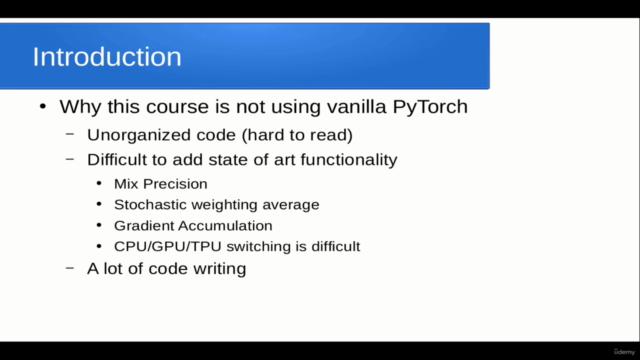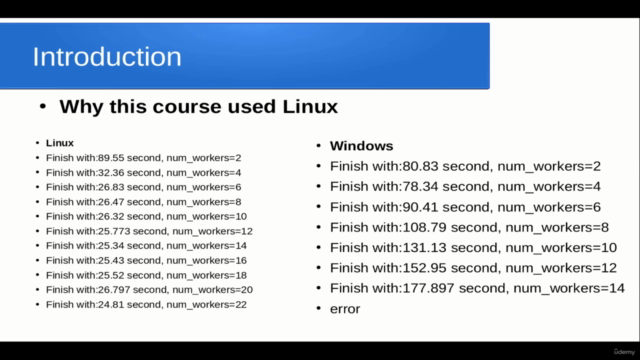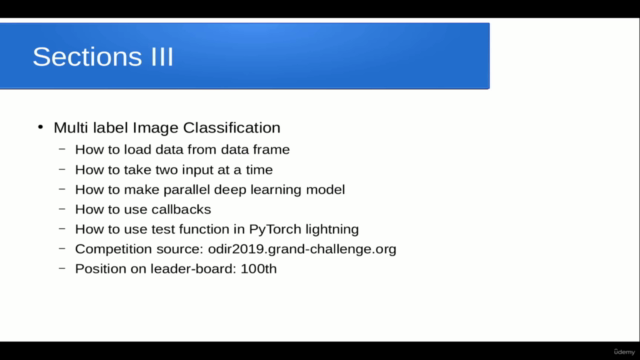Deep learning with PyTorch | Medical Imaging Competitions

Why take this course?
🚀 Master Deep Learning for Medical Imaging with PyTorch! 🕊️
Course Title: Deep Learning with PyTorch | Medical Imaging Competitions
Course Headline: 🎓 Dive into Real-World Medical Imaging Challenges with Advanced PyTorch Techniques!
Greetings, Aspiring Data Scientists!
This course is not for the faint of heart. It's designed for those who have already dipped their toes into the waters of deep learning with datasets like CIFAR and MNIST, and are ready to navigate the complexities of real-life medical imaging competitions. 👩💻✨
Course Overview:
This course, though not updated to the latest PyTorch version (it's currently based on PyTorch Lightning), still holds valuable insights into handling real-world medical imaging tasks. Despite some datasets becoming private and the content length restrictions on Udemy preventing it from being free, the foundational concepts of medical imaging competitions are as relevant as ever.
What You'll Learn:
Binary Classification:
- Acquire Data: Know how to get your hands on the data you need.
- Data Loading & Preprocessing: Learn to read data efficiently and apply essential augmentations.
- Model Training & Evaluation: Understand how data flows from folders to GPU and train models effectively.
- Metrics & Loss: Master calculating accuracy metrics and managing loss.
Multi-class Classification (CXR-covid19 Competition):
- Advanced Augmentations: Utilize Albumentations for sophisticated data augmentation.
- Custom Data Loaders: Write your own to handle specific data requirements.
- Learning Rate Scheduling & Callbacks: Optimize training with learning rate schedulers and various callback functions.
- Cross-validation for Foldered Images: Implement five-fold cross-validation on images stored in folders.
- Model Ensembling & Prediction Submission: Learn how to save, load models, ensemble models, and submit predictions to competition pages.
Multi-label Classification (ODIR Competition):
- Parallel Networks & Augmentation: Create a network that can handle two images simultaneously and apply augmentations accordingly.
- Custom Loss Functions: Adapt the binary cross-entropy loss for multi-label classification tasks using focal loss.
- Evaluation Metrics: Use competition-specific metrics to evaluate your model's performance.
Capstone Project: Estimating Covid-19 Infection Percentage
- Problem Formulation: Discover how to approach complex problems and develop a solution.
- Code Walkthrough: Dive into the code with detailed explanations.
- Ensemble Model Techniques: Explore the power of model ensemble to boost performance.
Semantic Segmentation:
- Data Handling with NIfTI Files: Learn to download, read, and handle medical image data in NIfTI format.
- Augmentation & Model Training: Apply augmentation to images and masks simultaneously and train models on NIfTI images.
- Visualization: Plot test images with corresponding ground truth and predicted masks for a clear understanding of results.
Who is this course for?
This course targets intermediate to advanced learners who are familiar with basic deep learning concepts and have prior experience with datasets like CIFAR and MNIST. If you're looking to apply your knowledge in the field of medical imaging, compete in relevant competitions, and push the boundaries of what's possible with PyTorch, this course is for you.
Why Take This Course?
While the course content is not the latest iteration of PyTorch (due to being based on PyTorch Lightning), the practical skills and knowledge you'll gain are evergreen. You'll learn how to approach complex medical imaging problems, apply cutting-edge techniques, and participate in competitions that will challenge and grow your expertise in deep learning.
Join us on this journey to conquer medical imaging with PyTorch! 🚀🤝
Please note: This course is a snapshot of the state-of-the-art when it was created using PyTorch Lightning. For the latest advancements in PyTorch, consider exploring resources that cover the newer versions of the library. However, the underlying concepts and methodologies covered in this course remain applicable and valuable for those looking to apply deep learning to medical imaging challenges.
Course Gallery




Loading charts...